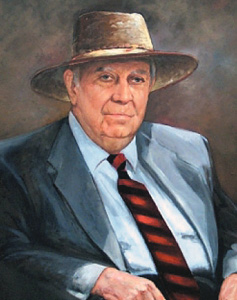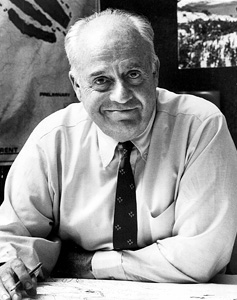Robert Trent Jones – A Biographical Timeline
His Early Years
Born in Ince-in-Makerfield, England, Robert Trent Jones accompanied his parents to the United States at the age of five. The family settled in East Rochester, New York
As an aspiring teenage golfer, RTJ breaks the course record at Genesee Valley Park in Rochester, NY, shooting a 69. An ulcer keeps Jones from pursuing competitive golf but he becomes the professional at Sodus Bay Heights Golf Club at 19. This allows Jones to meet professionals of his era, including Gene Sarazen, a lifelong friend and supporter.
Jones attended Cornell University, where he designed his own course of study to become a professional golf course designer. While at Cornell, he designed the back nine of Cornell’s Robert Trent Jones Golf Course.
Attending a frat party at Cornell, Jones meets Ione Tefft Davis from Montclair, NJ. They would marry in 1934.

“Robert Trent Jones, Sr. did not invent golf course architecture, it only seems that way. In a career that spanned nearly 70 years, Jones built or rebuilt some 400 courses in 45 states in the U. S. and 35 countries worldwide.”
– Ron Whitten, Golf Digest-
Thompson and the WPA
While competing to design Midvale G&CC, Stanley Thompson and Jones hit it off, and form the partnership that allows Jones to learn from the Canadian master.
Throughout the Depression, Jones pitches and lands projects to build public golf courses using public relief funds. This starts a trend towards professionally designed golf for the masses that would carry into the post-war golf boom.
Working for Thompson, Jones surveys Capilano, providing the routing and green complex sketches for western Canada’s most iconic course
Jones redesigns Green Lakes State Park Golf course to immediate success. Because he negotiated the club house concession business into his payment, this sets Jones on the path to prosperity amidst the lingering Depression.
Now mature in his design philosophies, and with a growing his list of clients and benefactors, Jones creates the business of golf course design, publishing his landmark manifesto, Golf Course Architecture.

“In the spring of 1930, when Jones was 24, he completed his course of studies, confident that as a golf course architect he had everything he needed except clients ”
– Author James R. Hansen, A Difficult Par-
